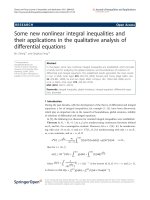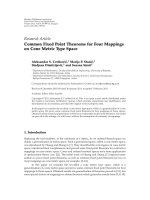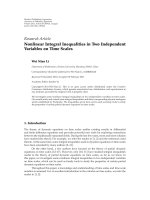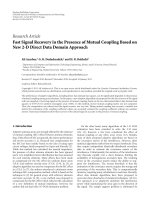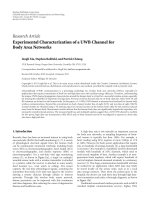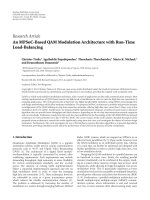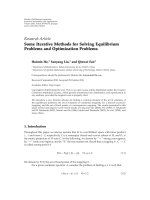Báo cáo hóa học: " Research Article Nonlinear Integral Inequalities in Two Independent Variables on Time Scales" potx
Bạn đang xem bản rút gọn của tài liệu. Xem và tải ngay bản đầy đủ của tài liệu tại đây (493.02 KB, 11 trang )
Hindawi Publishing Corporation
Advances in Difference Equations
Volume 2011, Article ID 283926, 11 pages
doi:10.1155/2011/283926
Research Article
Nonlinear Integral Inequalities in Two Independent
Variables on Time Scales
Wei Nian Li
Department of Mathematics, Binzhou University, Shandong 256603, China
Correspondence should be addressed to Wei Nian Li,
Received 7 December 2010; Accepted 18 February 2011
Academic Editor: Jianshe Yu
Copyright q 2011 Wei Nian Li. This is an open access article distributed under the Creative
Commons Attribution License, which permits unrestricted use, distribution, and reproduction in
any medium, provided the original work is properly cited.
We investigate some nonlinear integral inequalities in two independent variables on time scales.
Our results unify and extend some integral inequalities and their corresponding discrete analogues
which established by Pachpatte. The inequalities given here can be used as handy tools to study
the properties of certain partial dynamic equations on time scales.
1. Introduction
The theory of dynamic equations on time scales unifies existing results in differential
and finite difference equations and provides powerful new tools for exploring connections
between the traditionally separated fields. During the last few years, more and more scholars
have studied this theory. For example, we refer the reader to 1, 2 and the references cited
therein. At the same time, some integral inequalities used in dynamic equations on time scales
have been extended by many authors 3–11.
On the other hand, a few authors have focused on the theory of partial dynamic
equations on time scales 12–17. However, only 10, 11 have studied integral inequalities
useful in the theory of partial dynamic equations on time scales, as far as we know. In
this paper, we investigate some nonlinear integral inequalities in two independent variables
on time scales, which can be used as handy tools to study the properties of certain partial
dynamic equations on time scales.
Throughout this paper, a knowledge and understanding of time scales and time scale
notation is assumed. For an excellent introduction to the calculus on time scales, we refer the
reader to 1, 2.
2 Advances in Difference Equations
2. Main Results
In what follows, T is an arbitrary time scale, C
rd
denotes the set of rd-continuous functions, R
denotes the set of all regressive and rd-continuous functions, R
{p ∈R:1μtpt > 0for
all t ∈ T}, R denotes the set of real numbers, R
0, ∞,andN
0
{0, 1, 2, } denotes the
set of nonnegative integers. We use the usual conventions that empty sums and products are
taken to be 0 and 1, respectively. Throughout this paper, we always assume that T
1
and T
2
are time scales, t
0
∈ T
1
, s
0
∈ T
2
, t ≥ t
0
, s ≥ s
0
, ΩT
1
× T
2
, and we write x
Δ
t
t, s for the partial
delta derivatives of xt, s with respect to t,andx
Δ
t
Δ
s
t, s for the partial delta derivatives of
x
Δ
t
t, s with respect to s.
The following two lemmas are useful in our main results.
Lemma 2.1 see 18. If x, y ∈ R
, and 1/p 1/q 1 with p>1,then
x
1/p
y
1/q
≤
x
p
y
q
,
2.1
with equality holding if and only if x y.
Lemma 2.2 Comparison Theorem 1. Suppose u, b ∈ C
rd
, a ∈R
. Then,
u
Δ
t
≤ a
t
u
t
b
t
,t∈ T
2.2
implies
u
t
≤ u
t
0
e
a
t, t
0
t
t
0
e
a
t, σ
τ
b
τ
Δτ, t ∈ T.
2.3
Next, we establish our main results.
Theorem 2.3. Assume that ut, s, at, s, bt, s, gt, s, and ht, s are nonnegative functions
defined for t, s ∈ Ω that are right-dense continuous for t, s ∈ Ω, and p>1 is a real constant.
Then,
u
p
t, s
≤a
t, s
b
t, s
t
t
0
s
s
0
g
τ,η
u
p
τ,η
h
τ,η
u
τ,η
ΔηΔτ,
t, s
∈ Ω
2.4
implies
u
t, s
≤
a
t, s
b
t, s
m
t, s
e
y·,s
t, t
0
1/p
,
t, s
∈ Ω,
2.5
Advances in Difference Equations 3
where
m
t, s
t
t
0
s
s
0
a
τ,η
g
τ,η
p − 1
p
a
τ,η
p
h
τ,η
ΔηΔτ, 2.6
y
t, s
s
s
0
g
t, η
h
t, η
p
b
t, η
Δη,
t, s
∈ Ω. 2.7
Proof. Define a function zt, s by
z
t, s
t
t
0
s
s
0
g
τ,η
u
p
τ,η
h
τ,η
u
τ,η
ΔηΔτ,
t, s
∈ Ω.
2.8
Then, 2.4 can be written as
u
p
t, s
≤ a
t, s
b
t, s
z
t, s
,
t, s
∈ Ω. 2.9
From 2.9,byLemma 2.1, we have
u
t, s
≤
a
t, s
b
t, s
z
t, s
1/p
1
p−1/p
≤
a
t, s
p
b
t, s
z
t, s
p
p − 1
p
,
t, s
∈ Ω.
2.10
It follows from 2.8–2.10 that
z
t, s
≤
t
t
0
s
s
0
g
τ,η
a
τ,η
b
τ,η
z
τ,η
h
τ,η
p − 1 a
τ,η
p
b
τ,η
z
τ,η
p
ΔηΔτ
m
t, s
t
t
0
s
s
0
g
τ,η
h
τ,η
p
b
τ,η
z
τ,η
ΔηΔτ,
t, s
∈ Ω,
2.11
where mt, s is defined by 2.6. It is easy to see that mt, s is nonnegative, right-dense
continuous, and nondecreasing for t, s ∈ Ω.Letε>0 be given, and from 2.11,weobtain
z
t, s
m
t, s
ε
≤ 1
t
t
0
s
s
0
g
τ,η
h
τ,η
p
b
τ,η
z
τ,η
m
τ,η
ε
ΔηΔτ,
t, s
∈ Ω. 2.12
Define a function vt, s by
v
t, s
1
t
t
0
s
s
0
g
τ,η
h
τ,η
p
b
τ,η
z
τ,η
m
τ,η
ε
ΔηΔτ,
t, s
∈ Ω. 2.13
4 Advances in Difference Equations
It follows from 2.12 and 2.13 that
z
t, s
≤
m
t, s
ε
v
t, s
,
t, s
∈ Ω. 2.14
From 2.13, a delta derivative with respect to t yields
v
Δ
t
t, s
s
s
0
g
t, η
h
t, η
p
b
t, η
z
t, η
m
t, η
ε
Δη
≤
s
s
0
g
t, η
h
t, η
p
b
t, η
v
t, η
Δη
≤
s
s
0
g
t, η
h
t, η
p
b
t, η
Δη
v
t, s
y
t, s
v
t, s
,
t, s
∈ Ω,
2.15
where yt, s is defined by 2.7.Notingthatvt
0
,s1, yt, s ≥ 0, and using Lemma 2.2,
from 2.15,weobtain
v
t, s
≤ e
y·,s
t, t
0
,
t, s
∈ Ω. 2.16
It follows from 2.9, 2.14,and2.16 that
u
t, s
≤
a
t, s
b
t, s
m
t, s
ε
e
y·,s
t, t
0
1/p
,
t, s
∈ Ω.
2.17
Letting ε → 0in2.17, we immediately obtain the required 2.5. The proof of Theorem 2.3
is complete.
Remark 2.4. Letting T
1
T
2
R
and T
1
T
2
N
0
, respectively, we easily see that Theorem
2.3 reduces to Theorem 2.3.3c
1
and Theorem 5.2.4d
1
in 19.
Theorem 2.5. Assume that all assumptions of Theorem 2.3 hold. If at, s > 0 and at, s is nonde-
creasing for t, s ∈ Ω,then
u
p
t, s
≤a
p
t, s
b
t, s
t
t
0
s
s
0
g
τ,η
u
p
τ,η
h
τ,η
u
τ,η
ΔηΔτ,
t, s
∈Ω
2.18
implies
u
t, s
≤ a
t, s
1 b
t, s
n
t, s
e
w·,s
t, t
0
1/p
,
t, s
∈ Ω,
2.19
Advances in Difference Equations 5
where
n
t, s
t
t
0
s
s
0
g
τ,η
h
τ,η
a
1−p
τ,η
ΔηΔτ,
w
t, s
s
s
0
g
t, η
h
t, η
a
1−p
τ,η
p
b
t, η
Δη,
t, s
∈ Ω.
2.20
Proof. Noting that at, s > 0andat, s is nondecreasing for t, s ∈ Ω,from2.18, we have
u
t, s
a
t, s
p
≤ 1 b
t, s
t
t
0
s
s
0
g
τ,η
u
τ,η
a
τ,η
p
h
τ,η
a
1−p
τ,η
u
τ,η
a
τ,η
ΔηΔτ,
t, s
∈ Ω.
2.21
By Theorem 2.3,from2.21, we easily obtain the desired 2.19. This completes the proof of
Theorem 2.5.
Remark 2.6. If T
1
T
2
R
in Theorem 2.5, then we easily obtain Theorem 2.3.3c
2
in 19.
Theorem 2.7. Assume that ut, s, at, s, and bt, s are nonnegative functions defined for t, s ∈
Ω that are right-dense continuous for t, s ∈ Ω, and p>1 is a real constant. If f : Ω × R
→ R
is
right-dense continuous on Ω and continuous on R
such that
0 ≤ f
t, s, x
− f
t, s, y
≤ φ
t, s, y
x − y
, 2.22
for t, s ∈ Ω, x ≥ y ≥ 0,whereφ : Ω × R
→ R
is right-dense continuous on Ω and continuous
on R
,then
u
p
t, s
≤ a
t, s
b
t, s
t
t
0
s
s
0
f
τ,η,u
τ,η
ΔηΔτ,
t, s
∈ Ω
2.23
implies
u
t, s
≤
a
t, s
b
t, s
m
t, s
e
w·,s
t, t
0
1/p
,
t, s
∈ Ω,
2.24
where
m
t, s
t
t
0
s
s
0
f
τ,η,
p − 1 a
τ,η
p
ΔηΔτ, 2.25
w
t, s
s
s
0
φ
t, η,
p − 1 a
t, η
p
b
t, η
p
Δη,
t, s
∈ Ω. 2.26
6 Advances in Difference Equations
Proof. Define a function zt, s by
z
t, s
t
t
0
s
s
0
f
τ,η,u
τ,η
ΔηΔτ,
t, s
∈ Ω.
2.27
As in the proof of Theorem 2.3,from2.23, we easily see that 2.9 and 2.10 hold. Com-
bining 2.10, 2.27 and noting the assumptions on f, we have
z
t, s
≤
t
t
0
s
s
0
f
τ,η,
p − 1 a
τ,η
p
b
τ,η
z
τ,η
p
− f
τ,η,
p − 1 a
τ,η
p
f
τ,η,
p − 1 a
τ,η
p
ΔηΔτ
≤ m
t, s
t
t
0
s
s
0
φ
τ,η,
p − 1 a
τ,η
p
b
τ,η
p
z
τ,η
ΔηΔτ,
2.28
where mt, s is defined by 2.25.Itiseasytoseethat mt, s is nonnegative, right-dense
continuous, and nondecreasing for t, s ∈ Ω. The remainder of the proof is similar to that of
Theorem 2.3 and we omit it.
Remark 2.8. Letting T
1
T
2
R
and T
1
T
2
N
0
in Theorem 2.7, respectively, we can
obtain Theorem 2.3.4d
1
and Theorem 5.2.4d
2
in 19.
Theorem 2.9. Assume that ut, s, at, s, and bt, s are nonnegative functions defined for t, s ∈
Ω that are right-dense continuous for t, s ∈ Ω, and p>1 is a real constant. If f : Ω × R
→ R
is
right-dense continuous on Ω and continuous on R
, and Ψ ∈ CR
, R
such that
0 ≤ f
t, s, x
− f
t, s, y
≤ φ
t, s, y
Ψ
−1
x − y
,
2.29
for t, s ∈ Ω, x ≥ y ≥ 0,whereφ : Ω × R
→ R
is right-dense continuous on Ω and continuous
on R
, Ψ
−1
is the inverse function of Ψ, and
Ψ
−1
xy
≤ Ψ
−1
x
Ψ
−1
y
,x,y∈ R
,
2.30
then
u
p
t, s
≤ a
t, s
b
t, s
Ψ
t
t
0
s
s
0
f
τ,η,u
τ,η
ΔηΔτ
,
t, s
∈ Ω2.31
implies
u
t, s
≤
a
t, s
b
t, s
Ψ
m
t, s
e
w·,s
t, t
0
1/p
,
t, s
∈ Ω,
2.32
Advances in Difference Equations 7
where mt, s is defined by 2.25, and
w
t, s
s
s
0
φ
t, η,
p − 1 a
t, η
p
Ψ
−1
b
t, η
p
Δη,
t, s
∈ Ω. 2.33
Proof. Define a function zt, s by 2.27. Similar to the proof of Theorem 2.3, we have
u
p
t, s
≤ a
t, s
b
t, s
Φ
z
t, s
, 2.34
u
t, s
≤
p − 1 a
t, s
p
b
t, s
p
Φ
z
t, s
,
t, s
∈ Ω.
2.35
From 2.27, 2.35 and the assumptions on f and Ψ,weobtain
z
t, s
≤
t
t
0
s
s
0
f
τ,η,
p − 1 a
τ,η
p
b
τ,η
Ψ
z
τ,η
p
− f
τ,η,
p − 1 a
τ,η
p
f
τ,η,
p − 1 a
τ,η
p
ΔηΔτ
≤ m
t, s
t
t
0
s
s
0
φ
τ,η,
p − 1 a
τ,η
p
Ψ
−1
b
τ,η
p
z
τ,η
ΔηΔτ,
2.36
where mt, s is defined by 2.25. Obviously, mt, s is nonnegative, right-dense continuous,
and nondecreasing for t, s ∈ Ω. The remainder of the proof is similar to that of Theorem 2.3,
and we omit it here. This completes the proof of Theorem 2.9.
Remark 2.10. We note that when T
1
T
2
R
, Theorem 2.9 reduces to Theorem 2.3.4d
2
in
19.
Remark 2.11. Using our main results, we can obtain many integral inequalities for some
peculiar time scales. For example, letting T
1
R
, T
2
N
0
,fromTheorem 2.3, we easily
obtain the following result.
Corollary 2.12. Assume that ut, s, at, s, bt, s, gt, s and ht, s are nonnegative functions
defined for t ∈ R
, s ∈ N
0
that are continuous for t ∈ R
, and p>1 is a real constant. Then,
u
p
t, s
≤ a
t, s
b
t, s
t
0
⎧
⎨
⎩
s−1
η0
g
τ,η
u
p
τ,η
h
τ,η
u
τ,η
⎫
⎬
⎭
dτ, t ∈ R
,s∈ N
0
2.37
8 Advances in Difference Equations
implies
u
t, s
≤
⎧
⎨
⎩
a
t, s
b
t, s
m
∗
t, s
× exp
⎛
⎝
t
0
⎡
⎣
s−1
η0
g
τ,η
h
τ,η
p
b
τ,η
⎤
⎦
dτ
⎞
⎠
⎫
⎬
⎭
1/p
,
t ∈ R
,s∈ N
0
,
2.38
where
m
∗
t, s
t
0
⎧
⎨
⎩
s−1
η0
a
τ,η
g
τ,η
p − 1
p
a
τ,η
p
h
τ,η
⎫
⎬
⎭
dτ. 2.39
3. Some Applications
In this section, we present two applications of our main results.
Example 3.1. Consider the following partial dynamic equation on time scales
u
p
t, s
Δ
t
Δ
s
F
t, s, u
t, s
r
t, s
,
t, s
∈ Ω,
3.1
with the initial boundary conditions
u
t, s
0
α
t
,u
t
0
,s
β
s
,u
t
0
,s
0
γ, 3.2
where p>1 is a constant, F : T
1
× T
2
× R → R is right-dense continuous on Ω and continuous
on R, r : T
1
× T
2
→ R is right-dense continuous on Ω, α : T
1
→ R and β : T
2
→ R are
right-dense continuous, and γ ∈ R is a constant.
Assume that
|
F
t, s, v
|
≤ g
t, s
|
v
|
p
h
t, s
|
v
|
, 3.3
where gt, s and ht, s are nonnegative right-dense continuous functions for t, s ∈ Ω.If
ut, s is a solution of 3.1, 3.2, then ut, s satisfies
|
u
t, s
|
≤
a
0
t, s
M
t, s
e
Y·,s
t, t
0
1/p
,
t, s
∈ Ω,
3.4
Advances in Difference Equations 9
where
a
0
t, s
α
p
t
β
p
s
− γ
p
t
t
0
s
s
0
r
τ,η
ΔηΔτ,
M
t, s
t
t
0
s
s
0
a
0
τ,η
g
τ,η
p − 1
p
a
0
τ,η
p
h
τ,η
ΔηΔτ,
Y
t, s
s
s
0
g
t, η
h
t, η
p
Δη,
t, s
∈ Ω.
3.5
In fact, the solution ut, s of 3.1, 3.2 satisfies
u
p
t, s
α
p
t
β
p
s
− γ
p
t
t
0
s
s
0
F
τ,η,u
τ,η
ΔηΔτ
t
t
0
s
s
0
r
τ,η
ΔηΔτ,
t, s
∈ Ω.
3.6
Therefore,
|
u
t, s
|
p
≤ a
0
t, s
t
t
0
s
s
0
F
τ,η,u
τ,η
ΔηΔτ,
t, s
∈ Ω. 3.7
It follows from 3.3 and 3.7 that
|
u
t, s
|
p
≤ a
0
t, s
t
t
0
s
s
0
g
τ,η
u
τ,η
p
h
τ,η
u
τ,η
ΔηΔτ,
t, s
∈ Ω. 3.8
Using Theorem 2.3,from3.8, we easily obtain 3.4.
Example 3.2. Consider the following dynamic equation on time scales:
u
p
t, s
K
t
t
0
s
s
0
H
τ,η,u
τ,η
ΔηΔτ,
t, s
∈ Ω,
3.9
where K>0, p>1 are constants, H : T
1
× T
2
× R → R is right-dense continuous on Ω and
continuous on R.
Assume that
|
H
t, s, v
|
≤ h
t, s
|
v
|
,
t, s
∈ Ω, 3.10
where ht, s is a nonnegative right-dense continuous function for t, s ∈ Ω.Ifut, s is a
solution of 3.9, then
|
u
t, s
|
≤
K
1
n
t, s
e
q·,s
t, t
0
1/p
,
t, s
∈ Ω, 3.11
10 Advances in Difference Equations
where
n
t, s
K
1−p/p
t
t
0
s
s
0
h
τ,η
ΔηΔτ,
q
t, s
K
1−p/p
p
s
s
0
h
t, η
Δη,
t, s
∈ Ω.
3.12
In fact, if ut, s is a solution of 3.9, then
|
u
t, s
|
p
≤ K
t
t
0
s
s
0
H
τ,η,u
τ,η
ΔηΔτ,
t, s
∈ Ω.
3.13
It follows from 3.10 and 3.13 that
|
u
t, s
|
p
≤ K
t
t
0
s
s
0
h
τ,η
u
τ,η
ΔηΔτ,
t, s
∈ Ω.
3.14
Therefore, by Theorem 2.5,from3.14, we immediately obtain 3.11.
Acknowledgments
This work is supported by the National Natural Science Foundation of China 10971018,
the Natural Science Foundation of Shandong Province ZR2009AM005, China Postdoctoral
Science Foundation Funded Project 20080440633, Shanghai Postdoctoral Scientific Program
09R21415200, the Project of Science and Technology of the Education Department of
Shandong Province J08LI52, and the Doctoral Foundation of Binzhou University 2006Y01.
The author thanks the referees very much for their careful comments and valuable
suggestions on this paper.
References
1 M. Bohner and A. Peterson, Dynamic Equations on Time Scales: An Introduction with Applications,
Birkh
¨
auser, Boston, Mass, USA, 2001.
2 M. Bohner and A. Peterson, Eds., Advances in Dynamic Equations on Time Scales,Birkh
¨
auser, Boston,
Mass, USA, 2003.
3 R. Agarwal, M. Bohner, and A. Peterson, “Inequalities on time scales: a survey,” Mathematical
Inequalities & Applications, vol. 4, no. 4, pp. 535–557, 2001.
4 E. Akin-Bohner, M. Bohner, and F. Akin, “Pachpatte inequalities on time scales,” Journal of Inequalities
in Pure and Applied Mathematics, vol. 6, no. 1, article 6, pp. 1–23, 2005.
5 W. N. Li, “Some new dynamic inequalities on time scales,” Journal of Mathematical Analysis and
Applications, vol. 319, no. 2, pp. 802–814, 2006.
6 F H. Wong, C C. Yeh, and C H. Hong, “Gronwall inequalities on time scales,” Mathematical
Inequalities & Applications, vol. 9, no. 1, pp. 75–86, 2006.
7 W. N. Li and W. Sheng, “Some nonlinear dynamic inequalities on time scales,” Proceedings of the Indian
Academy of Sciences Mathematical Sciences, vol. 117, no. 4, pp. 545–554, 2007.
8 W. N. Li, “Some Pachpatte type inequalities on time scales,” Computers & Mathematics with
Applications, vol. 57, no. 2, pp. 275–282, 2009.
Advances in Difference Equations 11
9 W. N. Li, “Bounds for certain new integral inequalities on time scales,” Advances in Difference
Equations, vol. 2009, Article ID 484185, 16 pages, 2009.
10 D. R. Anderson, “Dynamic double integral inequalities in two independent variables on time scales,”
Journal of Mathematical Inequalities, vol. 2, no. 2, pp. 163–184, 2008.
11 D. R. Anderson, “Nonlinear dynamic integral inequalities in two independent variables on time scale
pairs,” Advances in Dynamical Systems and Applications, vol. 3, no. 1, pp. 1–13, 2008.
12 C. D. Ahlbrandt and Ch. Morian, “Partial differential equations on time scales,” Journal of
Computational and Applied Mathematics, vol. 141, no. 1-2, pp. 35–55, 2002.
13 J. Hoffacker, “Basic partial dynamic equations on time scales,” Journal of Difference Equations and
Applications, vol. 8, no. 4, pp. 307–319, 2002.
14 B. Jackson, “Partial dynamic equations on time scales,” Journal of Computational and Applied
Mathematics, vol. 186, no. 2, pp. 391–415, 2006.
15 M. Bohner and G. Sh. Guseinov, “Partial differentiation on time scales,” Dynamic Systems and
Applications, vol. 13, no. 3-4, pp. 351–379, 2004.
16 M. Bohner and G. Sh. Guseinov, “Double integral calculus of variations on time scales,” Computers &
Mathematics with Applications, vol. 54, no. 1, pp. 45–57, 2007.
17 P. Wang and P. Li, “Monotone iterative technique for partial dynamic equations of first order on time
scales,” Discrete Dynamics in Nature and Society, vol. 2008, Article ID 265609, 7 pages, 2008.
18 D. S. Mitrinovi
´
c, Analytic Inequalities, vol. 16 of Die Grundlehren der mathematischen Wissenschaften,
Springer, New York, NY, USA, 1970.
19 B. G. Pachpatte, Integral and F inite Difference Inequalities and Applications, vol. 205 of North-Holland
Mathematics Studies, Elsevier Science B.V., Amsterdam, The Netherlands, 2006.
